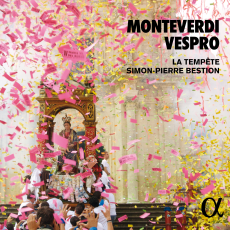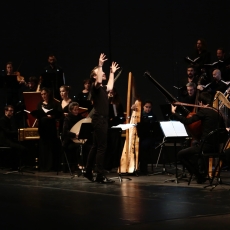La Tempête- Monteverdi: Vespro - MusicWeb International
Having dithered and dallied about what to say about this for months it’s probably as well to cut straight to the chase. This is the most fervent, colourful, moving, exotic, dramatic, musical, sonorous, exciting, extended and extraordinary account of Monteverdi’s Vespers I have ever heard, or am likely to ever hear. So there. My delaying (for which I apologise) in this case has nothing whatsoever to do with lingering doubts, it’s more about how best to warn those who want or expect the urtext to take the deepest of deep breaths and dive in anyway. I believe it would require the hardest of hearts not to be beguiled by this set.
I wonder how much Alpha’s generic disc title Vespro lends a clue? Although Monteverdi’s renowned 1610 setting of the Vespers is contained, complete, herein, others’ performances (and recordings) tend to have a duration of between 80 and 100 minutes. Here Simon-Pierre Bestion has extended the ritual, hence the disc’s title. It amounts to a complete reimagining of the work; Monteverdi’s original sequence is interspersed with half a dozen Gregorian antiphons and five earthy faux-bourdons, as well as a coolly delivered extra: Girolamo Frescobaldi’s Ricercar sopra Sancta Maria constitutes a restrained counterweight to the effervescence of Monteverdi’s similarly styled Sonata sopra Sancta Maria – the Ricercar is placed at the start of the second disc and follows the most vivacious account of Nisi Dominus I’ve ever experienced. Moreover, Bestion points out that Monteverdi’s instrumental requirements are only specified strictly at the beginning and end of the work; thus he has recruited a considerably beefed-up ensemble to be at his disposal, including harps, theorboes, guitars, a chitarrone and even a shofar-like serpent -an extended instrumental group whose lavish sonic possibilities Bestion exploits to the full. The whole ‘event’ extends to almost two and a half hours. I found the whole thing absolutely riveting and profoundly moving.
Listeners will get a good idea of what this entails right from the outset. A lusty faux-bourdon is delivered with impassioned earthiness by Bestion’s magnificently drilled choir – it imparts aromas imported from Corsica or Constantinople or possibly even further afield. It yields to the familiar Toccata which seems fatter – exotically coloured but remarkably alive. For those (like me) whose knowledge of Dufay, Binchois and Dunstaple (and their Burgundian contemporaries) is far from comprehensive, the term faux-bourdon, which literally means ‘false-drone’ alludes to a kind of homophonic parallel harmonisation whose smooth ‘flow’ enables ready comprehension of the text. In this regard the clarity of diction from Bestion’s substantial vocal forces is impeccable. In terms of this performance the five included are each presented directly before Monteverdi’s settings of the same texts, essentially providing listeners (or worshippers) the opportunity to hear the words twice. Lest readers imagine this is by any means dull or contributes to excessive prolixity – nothing could be further from the truth. Bestion is actually seeking to provide listeners with a contemporary parallel example of the word-setting alongside the Venetian master’s own; in the revealing booklet interview he also refers to the ‘Solesmisation’ of chant in the late 19th century, a process which he feels has over-civilised it and removed the rawness of its original colours and shapes, consequently depriving it of much of its fervency. Accordingly the singers, whether in unaccompanied larger groups (as in the opening faux-bourdon Domine ad adjuvandum me) or semi-accompanied (as in the second in this sequence – the parallel setting of Dixit Dominus) convey an almost primal, focused intensity which only amplifies the power of the ceremony. With Monteverdi’s own magnificent setting of the latter (which directly follows) one is both hooked and profoundly moved by the quality and passion of the singing, the opulence of the orchestration, the grandeur of the concept. Moments of stillness and quietude (as in the closing bars of the Dixit, or the antiphon Diffusa est gratia, here delivered almost like a Byzantine chant over a spare drone by the alto Eugénie De Mey) hit one like a train.
This cross-pollinated realisation of Monteverdi’s masterpiece is rich in unusual collisions of colour and style which can only enhance Bestion’s reputation as a ‘tinker-man’, Alpha Records’ own version of the enigmatic football manager Claudio Ranieri. On past discs his singular, interventionist approach has manifested itself in less familiar repertoire both in terms of programme building (on La Tempête – Inspired by Shakespeare - ALPHA 608 and Azahar - ALPHA 261) and performance styles (the superlative Larmes De Résurrection ALPHA 394 - review) but arguably the risks are increased exponentially in liturgical sequences as revered as Monteverdi’s Vespers. He makes the following case for his experiments in the booklet:
“I’m now convinced this music is oriented towards the Mediterranean, and towards the East. Even though it was already in decline, Venice was one of the two principal ports, with Genoa, that ruled over the Mediterranean. It looked towards …the silk trade, the Greek islands – Constantinople too. Venice hosted many merchant traders, Turks, Persians, also Sephardic Jews and Armenians…..the different popular traditions existed side by side, even influencing each other….I have simply tried to conjure up this whole wealth of traditions, and their mutual interchange”.
Frankly I don’t think this approach is all that far removed from the kind of thing Jordi Savall has been attempting in his Alia Vox epics over the last three decades. What I have found remarkable is that how convincingly this polyglot approach really seems to work with the Vespers – the sequence retains its coherence in ways I would never have expected had I read about Bestion’s project before hearing the results. In fact I detected absolutely nothing that seemed contrived or affected across the entire two and a half hours. I’m sure some will disagree, but I feel open-hearted (and open-minded) listeners will grow into it; for me it lasted not a moment too long.
The musicianship is awesome throughout – all his collaborators have embraced Bestion’s schemes with palpable enthusiasm and brought their ‘A’ games to the ceremony. In terms of the singers there are some instantly recognisable voices- the incomparable Claire Lefilliâtre (familiar as the regular soprano on Alpha’s remarkable sequence of discs with Vincent Dumestre’s flexible ensemble Le Poème Harmonique), mezzo Fiona McGown (a breathtaking Pulchra es on the first disc is testament to their intuitive mutual understanding) and tenor Sébastien Obrecht have been retained from the Larmes De Résurrection project but the strength in depth is exemplified by some of the additional singers – I’ve already mentioned Eugénie De Mey who has much to do throughout – other examples include the two ‘bass basses’ Florent Martin and Jean-Christophe Brizard who are quite unforgettable in the faux-bourdon Laudate Pueri. As for the instrumental ensemble, I have never heard the Vespers clothed in such sparkling colours – the opulence is unquestionable and the sonic possibilities seemingly inexhaustible – with each passing number one wonders “what can possibly follow that?” But Bestion always seems to find more. And I mean always. Alpha’s sonics are appropriately magnificent and miss nothing.
Crucially, Simon-Pierre Bestion makes no claims whatsoever to authenticity with this realisation of the Vespers. How could he? It’s a completely personal vision; it convinces by dint of his visionary extension of a heavenly work to an even more heavenly length. And by infusing a combination of popular, local flavours which certainly liberate it from cathedral or concert-hall formality and restore it to the people – all the people. I suspect old Claudio is smiling in the great beyond. Ambitious? For sure. Captivating and unforgettable? Definitely. Hear it.

